If you are looking for the most breathtaking natural landscapes in the Pacific Northwest, beating Washington State is pretty tough. Also known as the Evergreen State, Washington is a nature lover’s paradise. Located in the Pacific Northwest, Washington’s dense forests, rugged mountains, and large stretches of coastline are filled with rich and stunning wildlife. This incredible natural beauty and biodiversity are also reflected in the official state animals of Washington State. Let’s dive in and take a closer look!
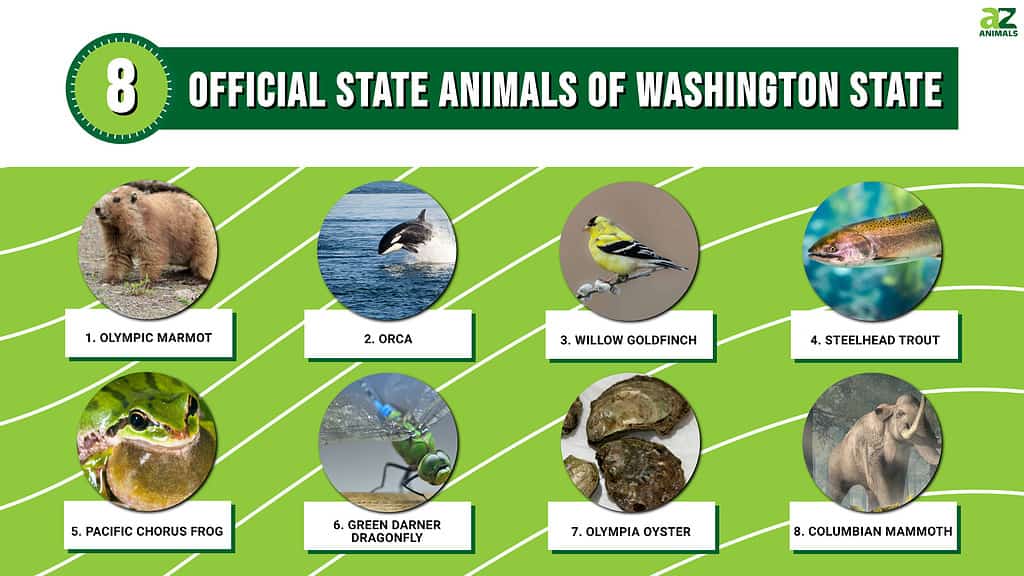
Among Washington’s state animals, the Olympia Oyster is the State Oyster.
©
1. State Endemic Mammal: Olympic Marmot (Marmota olympus)
The Olympic marmot is an excellent symbol for Washington, as it is the only endemic mammal in the state. Following a proposal from children at Seattle’s Westwood School, this unique animal became Washington’s official state endemic mammal in 2009. These adorable animals live in large groups of 12 or more in the western part of Washington in the Olympic Peninsula. They are commonly seen during the summer in Olympic National Park, particularly along Hurricane Ridge.
Olympic marmots are extremely social and gregarious animals. They form tight bonds with family members and often smell each other’s cheeks or touch each other’s noses in greeting. During the summer months, Olympic marmots enjoy basking in the sun and searching for food during the day, and returning to their burrows in the evening. They stay in their burrows from September to May for hibernation. Olympic marmots eat insects, fruits, legumes, herbs, flowers, and grasses.
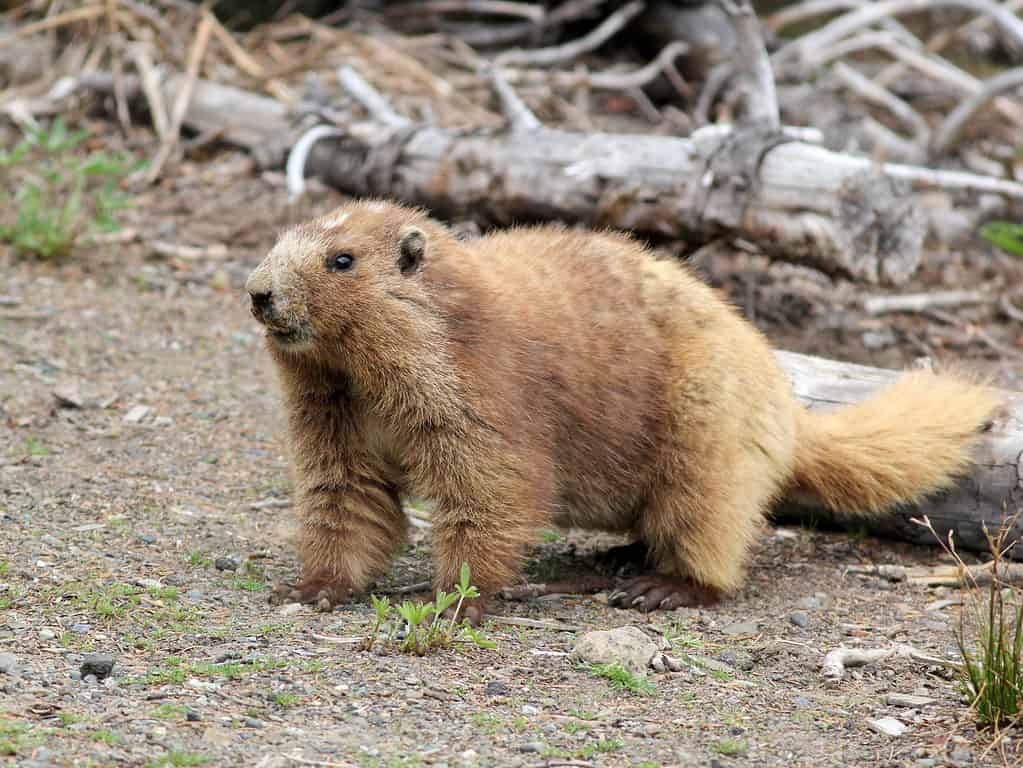
Olympic marmots live in groups of 12 or more in western Washington in the Olympic Peninsula.
©Randy Bjorklund/Shutterstock.com
2. State Marine Mammal: Orca (Orcinus orca)
Orcas are well known in the state of Washington. Also known as killer whales, orcas became the official state marine mammal in 2005, thanks to a proposal from the second graders of Crescent Harbor Elementary School. One of the main goals of making the orca an official state animal in Washington was to bring awareness to these incredible animals and help to protect their habitat. Several groups of orcas annually migrate in the marine waters of Washington State. The most well-known are three orca pods of the famous Southern Resident killer whales of Puget Sound.
The Southern Resident orcas are different than your typical killer whales in that they almost exclusively eat seafood like Chinook salmon rather than hunting marine mammals. This is one of the many things that make orca so unique: each pod or family group has its own culture with unique behaviors and hunting techniques. In addition, orcas are easily recognized with distinct black and white markings.
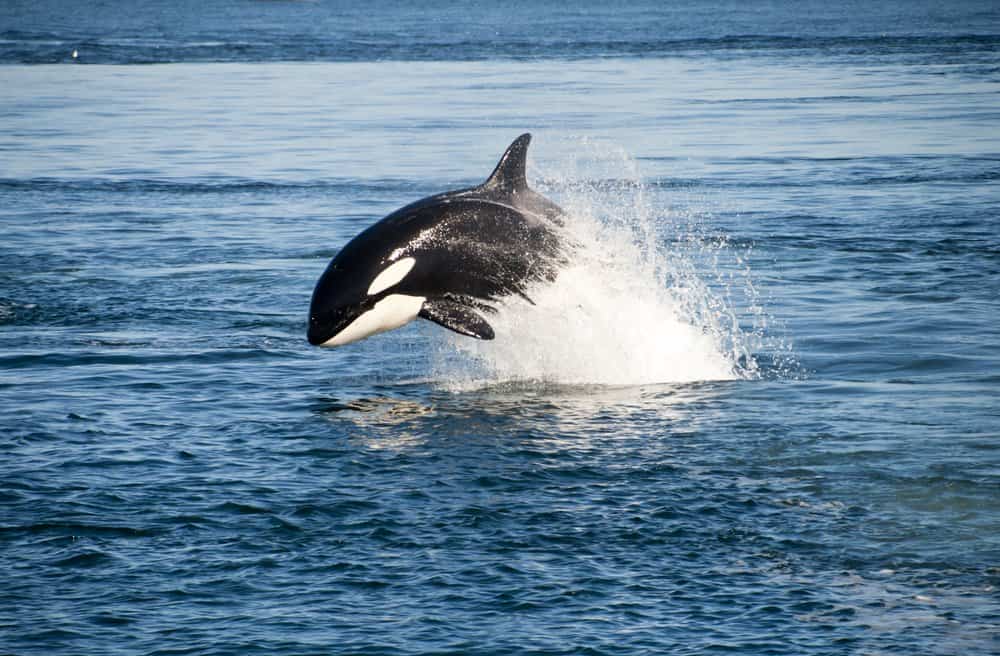
One goals of making the orca an official state animal of Washington was to help to protect its habitat.
©qingqing/Shutterstock.com
3. State Bird: Willow Goldfinch (Spinus tristis salicamans)
The official state bird of Washington State is the willow goldfinch, which was designated as a state symbol in 1951. These delicate and acrobatic birds have yellow bodies with black and white wings. Females, however, tend to have a dull or olive-yellow color with dark brown wings and a dark brown tail. In addition, both males and females have brownish coloring during the winter months.
Willow goldfinches are small birds and only reach about 5 inches in length. They are very active birds with impressive flying abilities, gracefully dipping and rising in a wave-like pattern as they soar through the sky. Willow goldfinches primarily eat seeds and are particularly fond of elm, thistle, and sunflower seeds.
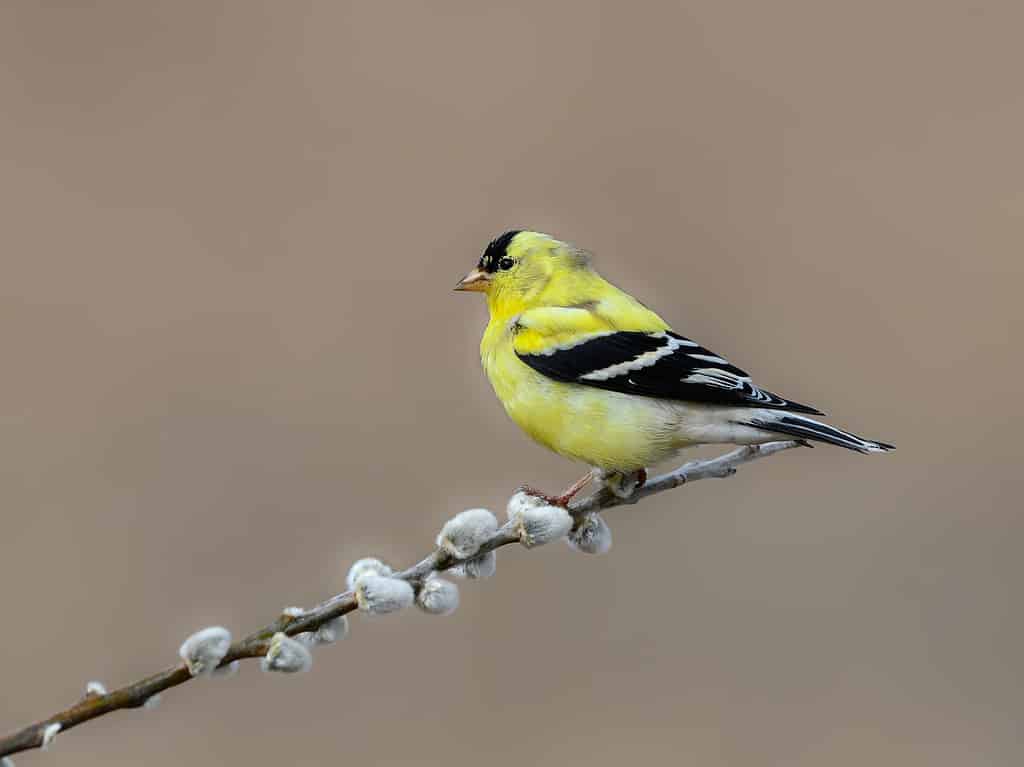
Willow goldfinches are small birds, only growing to around 5 inches in length.
©FotoRequest/Shutterstock.com
4. State Fish: Steelhead Trout (Oncorhynchus mykiss irideus)
The steelhead trout has been the official state fish of Washington since 1969. This fish is one of the most popular for recreational fishing — a popular sport and major industry in the state of Washington. Steelhead trout are anadromous fish and return to the freshwater rivers where they were born to spawn.
These fish have long bodies covered with silvery-blue scales that shimmer in the sunlight. Their bellies are a bright white color, which is separated from their silvery spotted backs with a translucent line of pinkish coloring. The steelhead trout is actually the same species as the rainbow trout. The only difference is that rainbow trout live only in freshwater, while steelhead trout move between freshwater and saltwater habitats.
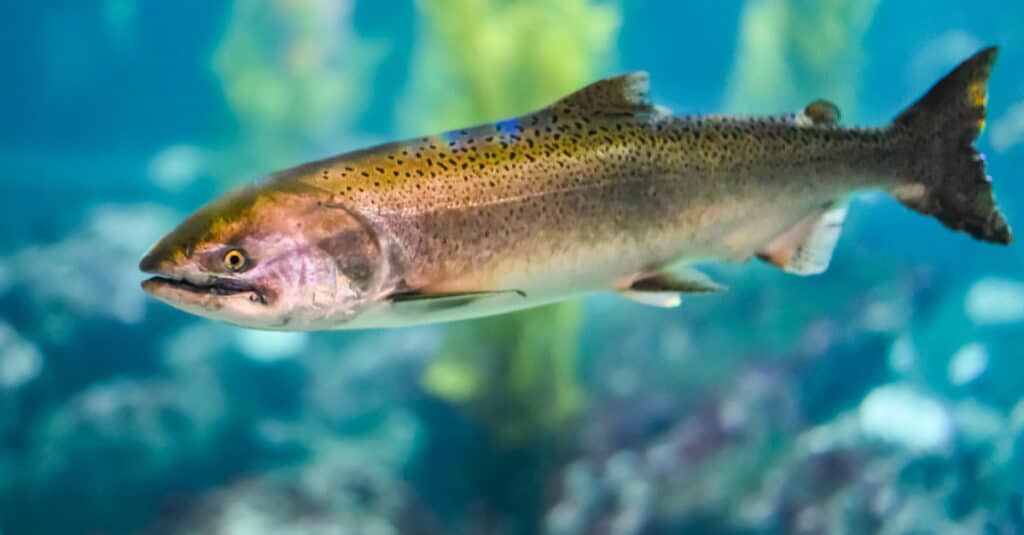
Steelhead trout are one of the most popular species for recreational fishing in the state.
©David A Litman/Shutterstock.com
5. State Amphibian: Pacific Chorus Frog (Pseudacris regilla)
In 2007, the Pacific Chorus frog (or Pacific tree frog) was designated as the official state amphibian of Washington, following a proposal from children at Boston Harbor Elementary School. The Pacific chorus frog is native to Washington and lives in every state county. These frogs are not only cute and charismatic, but they are also very helpful to the ecosystems of Washington and eat many pesky insects like mosquitoes.
Pacific chorus frogs are no bigger than 2 inches long and can be green, gray, brown, or tan. No matter their color, however, each frog has a recognizable black stripe that goes through the eye down to the shoulder. Like their name, Pacific chorus frogs make beautiful sounds at night, swelling their throats up to three times larger than the size of their heads!
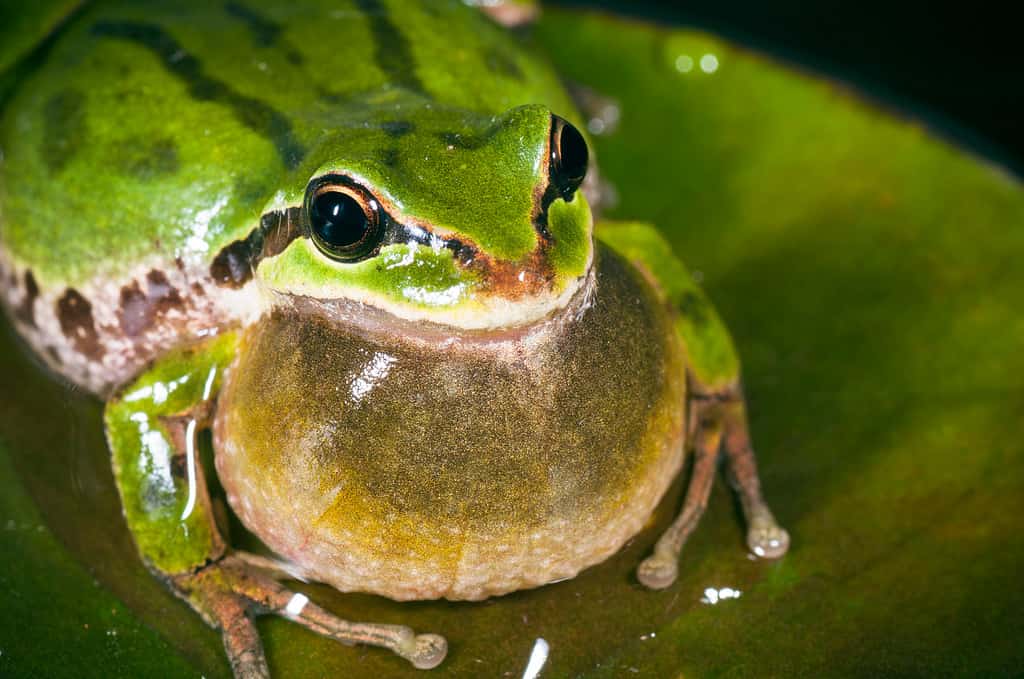
Pacific chorus frogs are helpful to the ecosystems of Washington, eating many insects such as mosquitoes.
©Elementspace/Shutterstock.com
6. State Insect: Green Darner Dragonfly (Anax junius)
The green darner dragonfly became the Washington official state insect in 1997 after students from Crestwood Elementary proposed the idea to the Washington State legislature. These dragonflies live all over the state of Washington. The green darner dragonfly is one of the fastest dragonflies and can fly 25 to 35 mph. It is also one of the largest dragonflies, with a 4- to 6-inch wingspan and a body that is 2.25 to 3.5 inches long. Its dazzling green thorax is sometimes accented by a deep red stripe that runs down the middle of its blue abdomen.
Green darner dragonflies are skilled aerial hunters — they catch and eat their prey in mid-flight! They are helpful insects because they eat many pests, like mosquitoes. Green darner dragonflies are some of the most common dragonfly species in North America. They migrate from the northern United States down into Texas and even Mexico.

The green darner dragonfly is one of the fastest dragonfly species, capable of flying 25 to 35 mph.
©Photoongraphy/Shutterstock.com
7. State Oyster: Olympia Oyster (Ostrea lurida)
Although oysters are quite common in Washington today, most are foreign to this state. In fact, the Olympia oyster — Washington’s official state oyster since 2014 — is the only oyster species native to the Puget Sound in Washington State. It is an edible oyster species and can also be found along the Northern Pacific Coast in North America, and up into some of the southern sections of Alaska. Olympia oysters grow around 2 to 3 inches long and have rounded or oval-shaped shells. They can come in different colors, like white or purplish black, and often have brown or yellow stripes.
While they were once extremely abundant in Washington, in the early 1900s, many people harvested Olympia oysters on the state’s coasts and beaches, which caused many of their large populations almost to disappear entirely! People also started farming other oyster species that threatened the native populations of Olympia oysters. In addition, Olympia oysters are also threatened by polluted water, habitat destruction, and dangerous animals. However, in 1998 the Washington Department of Fish and Wildlife adopted a new restoration strategy to help protect and replenish wild Olympia oysters in the state.
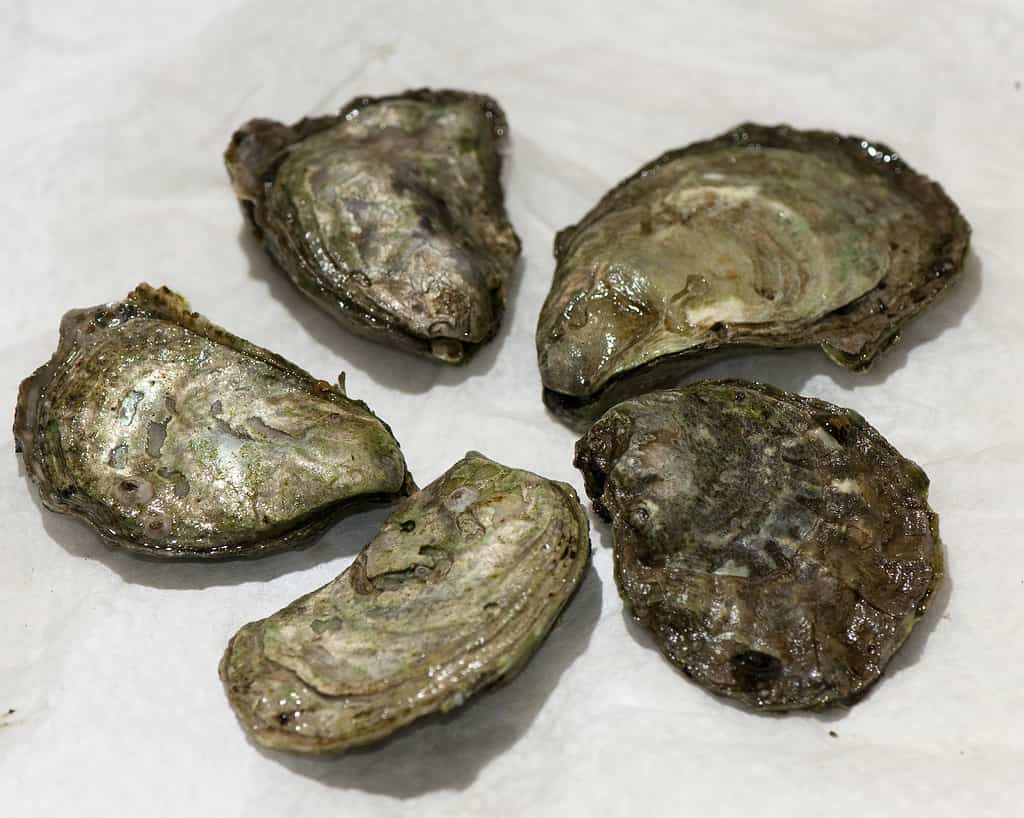
The Olympia oyster is the only oyster species native to the Puget Sound in Washington State.
©VIUDeepBay, CC BY 2.0 <https://creativecommons.org/licenses/by/2.0>, via Wikimedia Commons – License
8. State Fossil: Columbian Mammoth (Mammuthus columbi)
Students from Windsor Elementary School helped the Columbian mammoth become Washington’s official state fossil in 1998. These giant mammals once lived all across the North American continent during the Pleistocene epoch and were about the size of today’s modern elephants. Over the ages, there have been many different types of mammoths. However, the Columbian mammoth was one of the biggest to ever walk on the earth. This giant mammal was 13 feet tall, weighed 22,000 pounds, and had massively long tusks.
The Columbian mammoth was also one of the last species of mammoths to go extinct, disappearing from the Earth around 10,000 to 11,000 years ago. Its extinction was likely caused by habitat loss as well as hunting by humans. Fossils from Columbian mammoths are common in Washington, especially in the Olympic Peninsula region.
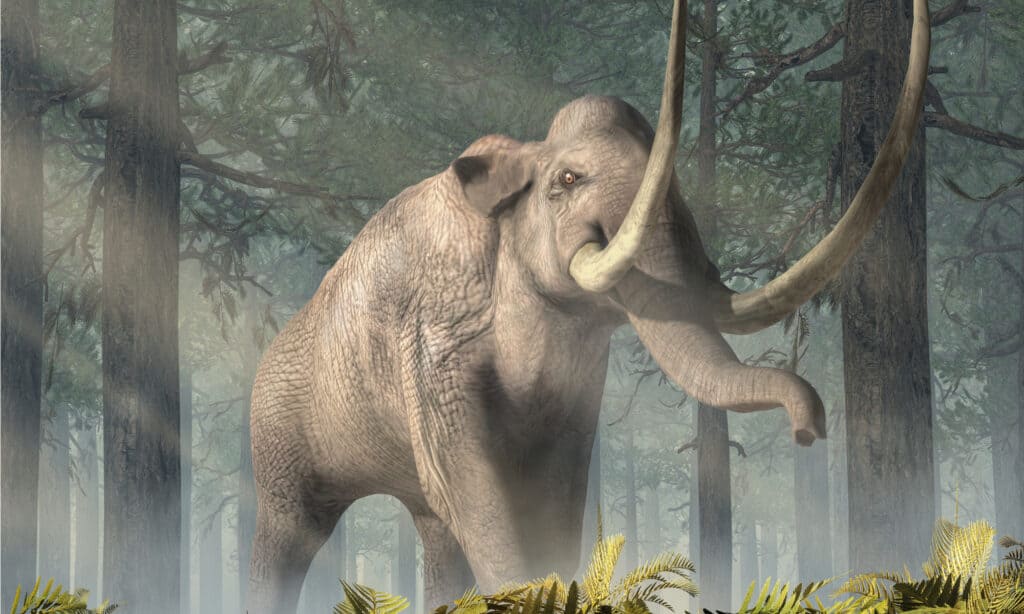
The Columbian mammoth was one of the largest ever, growing to 13 feet tall and weighing 22,000 pounds.
©Daniel Eskridge/Shutterstock.com
Summary of the 8 Official State Animals of Washington State
Here’s a recap of the eight creatures that have been designated official state animals of Washington.
| Number | State Designation | Animal | Scientific Name |
|---|---|---|---|
| 1 | State Endemic Mammal | Olympic Marmot | Marmota olympus |
| 2 | State Marine Mammal | Orca | Orcinus orca |
| 3 | State Bird | Willow Goldfinch | Spinus tristis salicamans |
| 4 | State Fish | Steelhead Trout | Oncorhynchus mykiss irideus |
| 5 | State Amphibian | Pacific Chorus Frog | Pseudacris regilla |
| 6 | State Insect | Green Darner Dragonfly | Anax junius |
| 7 | State Oyster | Olympia Oyster | Ostrea lurida |
| 8 | State Fossil | Columbian Mammoth | Mammuthus columbi |
The photo featured at the top of this post is © Virginie Merckaert/Shutterstock.com
Thank you for reading! Have some feedback for us? Contact the AZ Animals editorial team.






